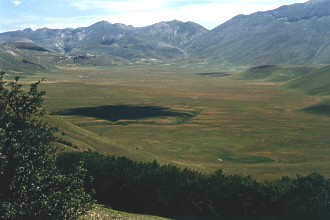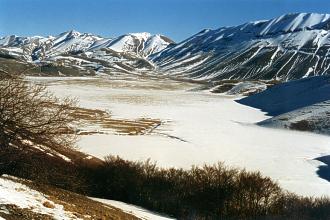|
"Are you coming after Fatima with us?", was the short text message that appeared on my cell phone. And because I welcome an escape from civilization at any time of year, it was immediately clear that I would spend the end of July with an expedition of flyers about 100km Southeast of Rome, in a beautiful valley of the village of Castelluccio, in places where the night is absolutely quiet, you can see the Milky Way from horizon to horizon and the air is as clean as it is only high up in the mountains, about 1300 meters above sea level. In the places where a pilot lands right by his tent at the bottom of a circular valley witha radius of 6 kilometers, flat as a tabletop, with endless grass without trees or bushes, where taking off is possible from any slope, rising all around and where the eastern side of the valley is ruled by majestic Monte Vettore with its peak at 2476 meters above sea level.

About Fatima, whose name is carved into every other table in Lu Crinu, a wine bar owned by Giuseppe the globetrotter in the village of San Pellegrino, we'll get to later.
It's a little out of the way
In the interests of experiment we decided to divide the expedition into two groups, with our group from Ostrava, the "A" group, heading out to explore the quickest route without concern of financial loses and sacrifice of lives. The result was 16 hours of wild driving where the indicator of the speedometer was not, under any circumstances, to drop below 100km/hr. and acceptable were only a few short stops for peeing, vomiting and similar silliness, with which some of the weaker members unnecessarily delayed the fluency of our hellish ride. Upon reaching our goal we calculated a distance of 1540km.
There are certainly alternate possible ways of reaching Castelluccio high up in the Italian mountains. We took the quick route along Austrian highways through Vienna, Graz and Villach, then in Italy on the toll highways through Udine, Mestre, Padova, Bologna, Firenze and onward South in the direction of Rome. Navigationally the route is very straightforward, and besides, all roads lead to Rome. About 60km before Rome, however, you must exit the highway towards the city of Terni, and after about 30km take the Terni Ovest and drive into this city. The road tolls in Italy come to about 1,100 Czech Crowns ($34). Divided among three pilots it's almost nothing.
In the city of Terni is where the only navigationally difficult segment of the journey begins. We found the best method was to follow signs for Norcia, Cascia and Visso in the winding streets of the city. They all point in the same direction, and at least one of those placenames is at every intersection. Upon a happy departure from Terni the signs for Visso predominate. But you have to turn off to the right about 19km before Visso, towards Norcia. The exit is clearly marked and immediately upon exiting the road turns into a tunnel.
While driving through the narrow streets of Norcia it is necessary to follow the signs towards Forca Canapine. Two kilometers out of Norcia is the important, "meeting point", at the co-ordinates: N42°46.198' E13°06.226' in the form of an intersection with a drinking water source. From here you follow the signs, left, towards Castelluccio and from there only 28km along the winding roads on the southern side of the mountain, with a final drive through a mountain pass at 1500m above sea level and following a descent to the bottom of the valley Castelluccio about 200m lower. Already while driving through the mountain pass you are prestented with a view of a valley that is difficult to describe, but at that moment it becomes clear to every pilot that they are in the right place.

But let us return for a moment to the meeting point just outside of Norcia at the water well. Right off there are several very rational reasons for spending the first night at this place, leaving the remaining 28km to Castelluccio for the morning. It may seem nonsensical at first, but only at first. Why?

The majority of pilots will certainly time their arrival to this location for evening so that, following a long or short sleep, they can fly the next day. In the vicinity of the water source it is possible to throw a sleeping bag, along with the tired pilot inside, on the surrounding grass and fall asleep without too much thinking. Not so, however, in the valley of Castelluccio which is no longer 700m above sea level but an even 1300.
|
There it is already sensible to put up a tent for the night and prepare well for the morning frost. The dead tired pilot is not much in the mood for this, understandably and furthermore it's already pitch black everywhere. The result tends to be a cold the first day of his stay.
The second reason is Italian drivers, who at night often tear intoxicated along the winding mountain roads and who, even sober, do not respect road signs. Admittedly, they do so with bravado, but when two high beams flash out across the entire road, around a bend coming directly at the Czech driver it is unpleasant at best. Then of course driving into the valley of Castelluccio in the morning is far more enjoyable when the photogenic view of the valley filled with morning fog out of which rise the majestic peaks lit by the morning sun takes your breath away.

The second possible route to Castelluccio, which we verified on our return journey, is to turn off southeast at Bologna, taking the highway along the eastern coastline of Italy driving by Rimini and Ancona all the way to San Benedetto, where it's necessary to turn off right, inland, toward Acsoli Piceno. At this city it is best to stick to signs for Roma and about 30km after Ascoli Piceno in the village of Trisungo turn off right toward Pretare. After several serpentines is an exit left, upwards to Forca di Presta, following which remains only the descent to the valley floor of Castelluccio.
The road along the shore works out, time and distance wise, slightly better (1490km) than the route towards Rome. Even the road tolls are slightly less expensive. And the road along the seashore for a native of a land-locked country can be quite interesting if driven in the daytime.
At the bottom of the enclosed valley one finds several public campgrounds near each other at co-ordinates N42°48.419'E13°12.004'. The campsites are only symbollically dileneated with tape and can be used free of charge. Only making fires is prohibited and anyway, there' nothing far and wide to burn.

Hardly 50 meters from the road is a source of drinking water in the form of a spring with troughs for animals and of course for pilots as well. The water is crystal clear, ice cold and very good, so that even the dead sheep that, poor thing didn't make it to the trough, didn't ruin the idyllic setting for us. In any of the many troughs a pilot can even bathe whole, although bathing in cold water at 1300m is understandably not for everyone.

Even when temperatures in Rome reach over 30°C, in Castelluccio it is necessary to count on morning temperatures below freezing. During the day of course the mountain sun bears down with such ferocity that not only shorts are necessary, but a cap with visor comes in handy as well. Frost on everything left out over night is a common occurrence, summer or not. Another alternative is to come out of the tent after 9 a.m. when already over some of the hills the first signs of convection currents appear and the first eager aviationists are taking off, and the temperature on the valley floor is pleasant.
All of this leads to one important conclusion and that is that Castelluccio, in contrast to Bassano is not good for early Spring flying. The snow often stays here well into May.

If upon arriving in Castelluccio too early the eager pilot is surprised by snow drifts on the runway roads, he can make use of the two southwest runways towards the neighboring valley of Norcia and fly there. This valley lies 600m lower and on both runways, San Pellegrino and Rifugio Perugia the afternoon thermal currents reliably overpower any not too strong winds.
|






